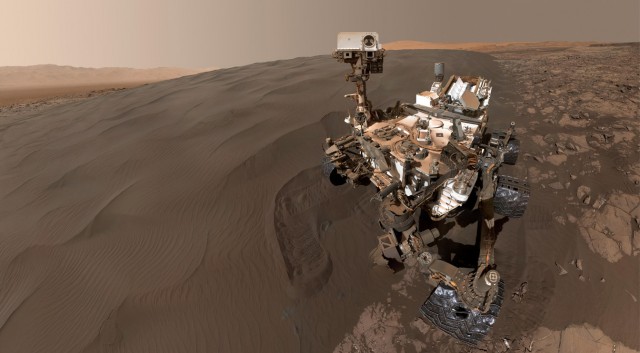
Curiosity has been on Mars for more than six years, helping scientists unravel the geological history of the red planet. It has found evidence of ancient bodies of water, organic material, and more. Curiosity was outfitted with instruments for these tasks, but NASA has managed to repurpose one of its sensors to provide some new data. Using the rover’s navigation gear, NASA analyzed gravitational fields on Mars to study the history and origins of Mount Sharp.
NASA considered dozens of landing sites for Curiosity but eventually settled on Gale Crater in part because it provided access to Mount Sharp. By climbing the slopes of this craggy formation, the rover could investigate different sections of Mars’ geological history. Data from the rover shows that the crater harbored lakes and streams in the distant past, but what of Mount Sharp itself?
Mount Sharp rises 5.5 km (18,000 ft or 3.4 miles) above the floor of Gale Crater, which is taller from base to peak than Mount Everest. A peak this high in a crater is unusual even on Mars, so scientists have long debated how it came to be there. Some suspected it is a small eroded remnant of a massive sedimentary structure that may have filled the crater in the distant past. Others believe Mount Sharp formed from compacted material driven by winds over the source of many years.
That’s where Curiosity comes in. While NASA didn’t equip the rover with sensors specifically to measure gravity, it does have sensitive engineering accelerometers for navigation. The team used readings from the accelerometers to map the gravitational field strength at more than 700 locations along the rover’s path up Mount Sharp. From this data, the scientists estimated the density of rock in the mountain at 1,680 kg (about 3,704 pounds) per cubic meter. That might sound like a lot, but it’s actually quite low.

The low density of rocks in Mount Sharp suggests that it contains very porous rock. That’s not what you’d expect for a sedimentary structure that was once buried under other several kilometers of rock. However, it does match the profile of a mountain built up from windblown dust.
Future missions to Mars could carry more sensitive instruments designed to take gravitational readings. The upcoming Mars 2020 won’t have room for it, though. That missions will focus mostly on astrobiology to hunt for evidence of ancient life on Mars.




























